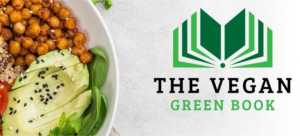Learn How to Make Almond Milk at home with just three simple ingredients–almonds, water, and a pinch of salt–plus delicious flavor variations to suit your taste. This easy, budget-friendly recipe is smooth, creamy, naturally dairy-free, and worlds better than store-bought!
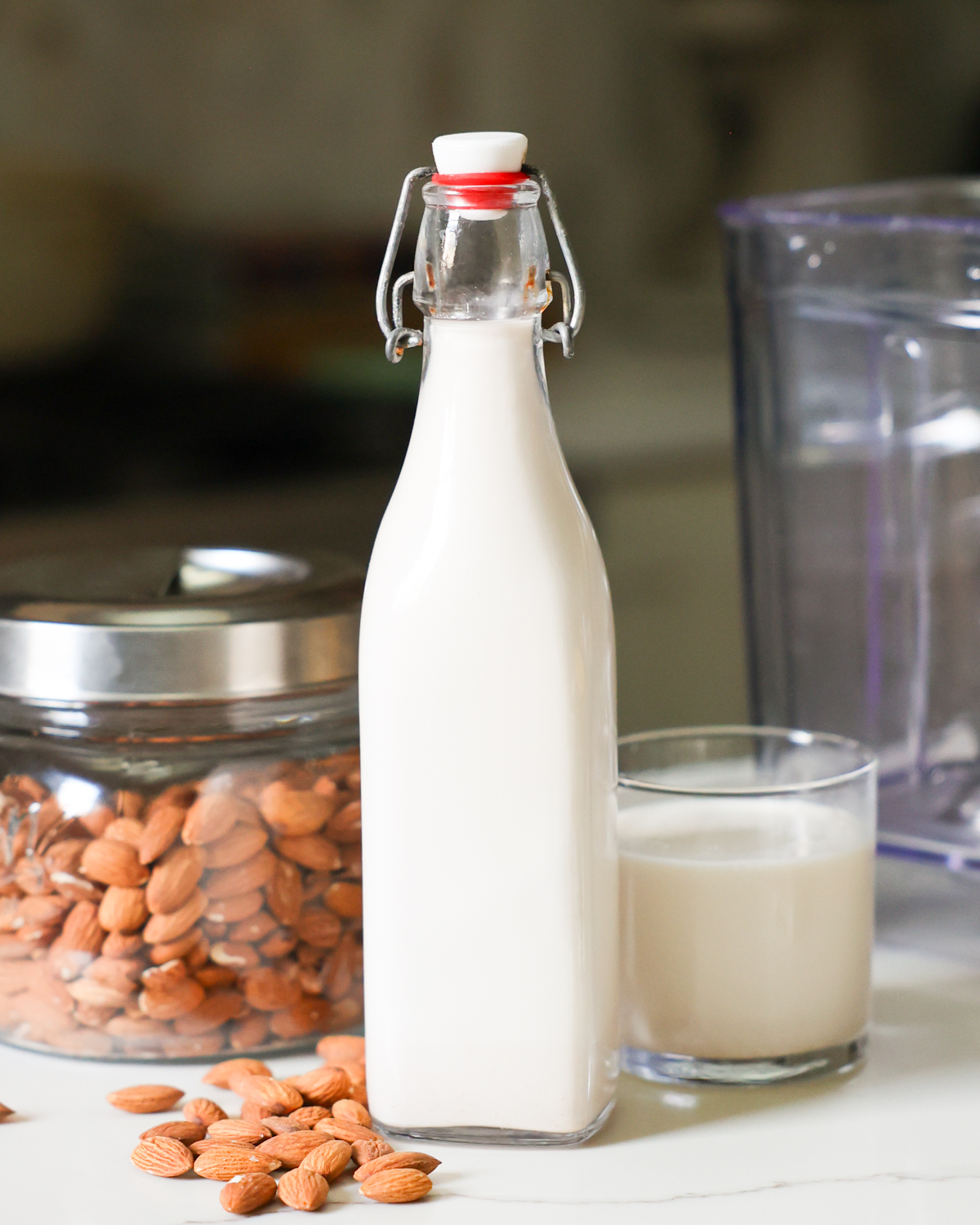

This post was originally published on January 23, 2014. It was updated with new recipe information and photos on October 9, 2025.
Homemade almond milk tastes completely different than store-bought brands. Better, of course. It tastes like creamy, fresh, real almonds. Once you make your first batch, you’ll never want to go back. If you’ve ever wondered, “How is almond milk made?” it’s quite simple: soak, blend, and strain. That’s it!
Making DIY alm ond milk at home gives you complete control over flavor and sweetness, and it’s healthier compared with most store-bought versions that contain unnecessary additives, stabilizers, and preservatives.
Use your homemade milk in warm winter drinks like hot chocolate, chai, turmeric lattes, matcha, or coffee, or as a creamy base for smoothies.
For more easy plant-based drink recipes, try My Daily Green Juice, Watermelon Smoothie, or Hibiscus Elderberry Ginger Tea.
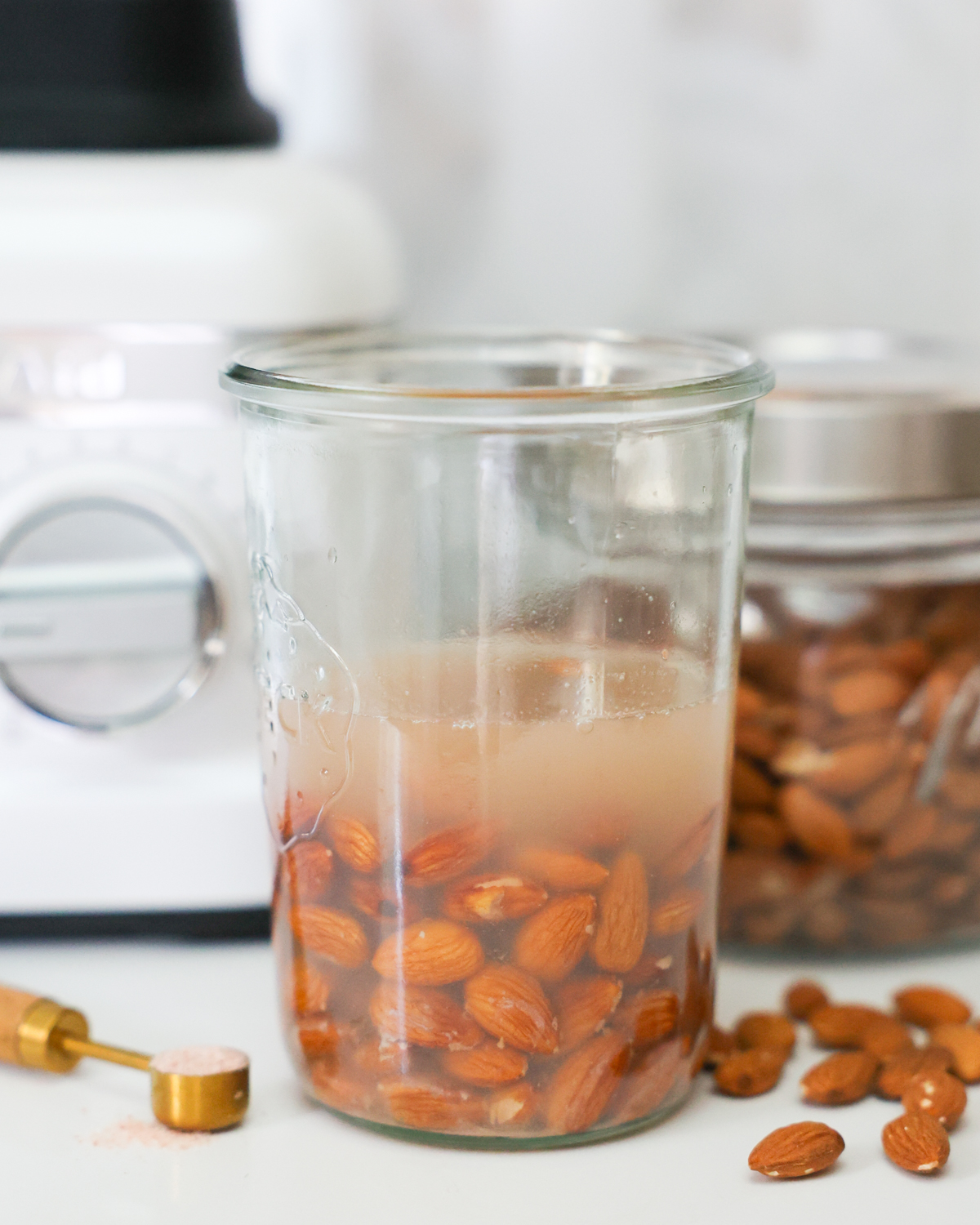

Ingredients
Almonds: Use raw, unsalted almonds for the richest and nuttiest almond milk flavor. Blanched almonds can also be used for a milder flavor.
Water: Always use purified or spring water for the cleanest, freshest taste.
Salt: Just a pinch of salt is all you need to balance the subtly sweet flavor of the almonds.
Optional Flavor Additions: Naturally sweeten and flavor the milk with refined-sugar-free additions (dates or maple syrup), warming spices, fragrant vanilla, cacao powder, berry powders, and more. There are so many add-ins—see Recipe Mix-Ins below for more info!
How to Make Almond Milk
This popular plant-based milk is shockingly easy to make! Here’s how to do it:
- Soak the almonds. Place raw almonds in a bowl and cover with purified or spring water. Soak overnight (8-12 hours) until they are plump and soft. Drain and rinse before using.
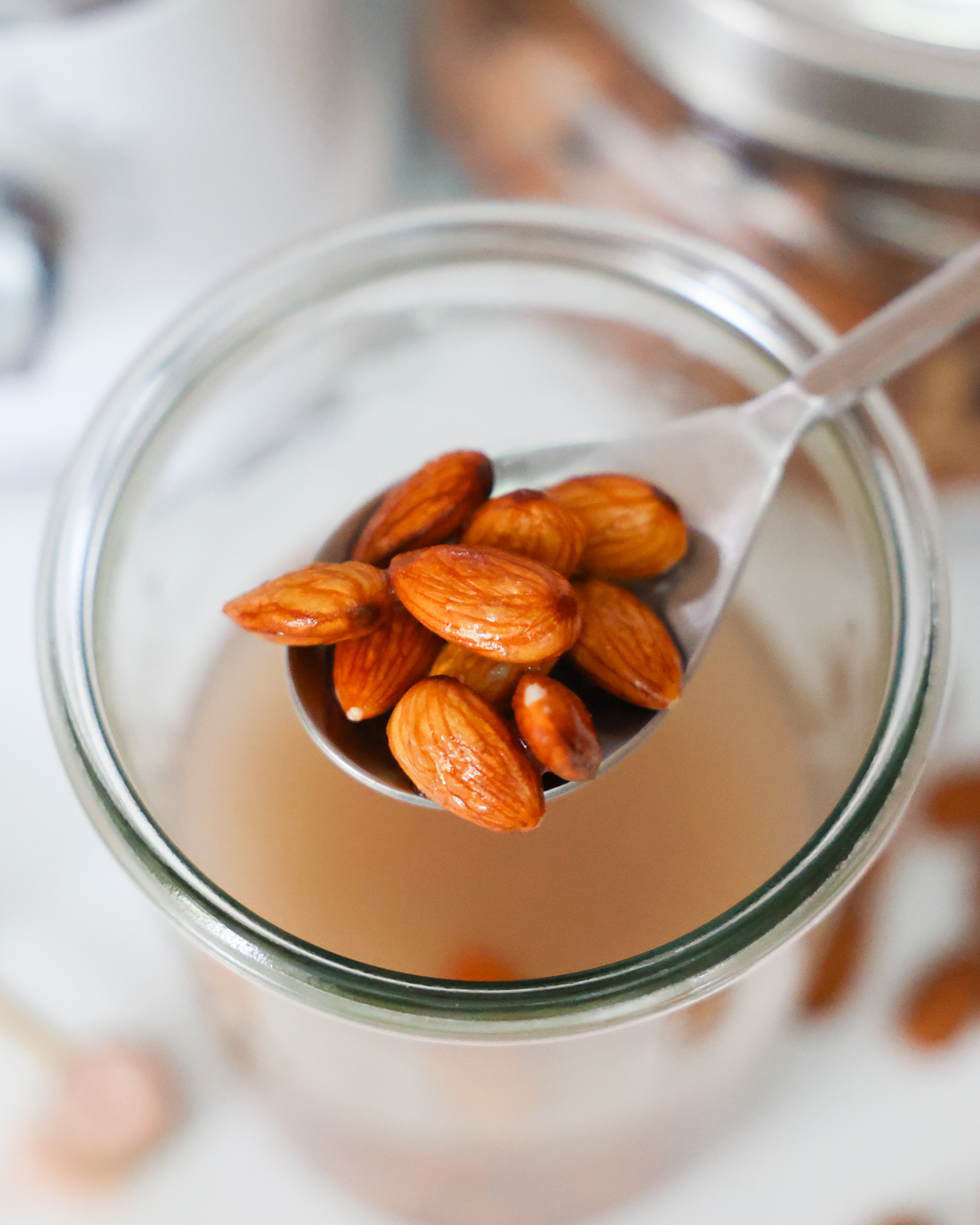

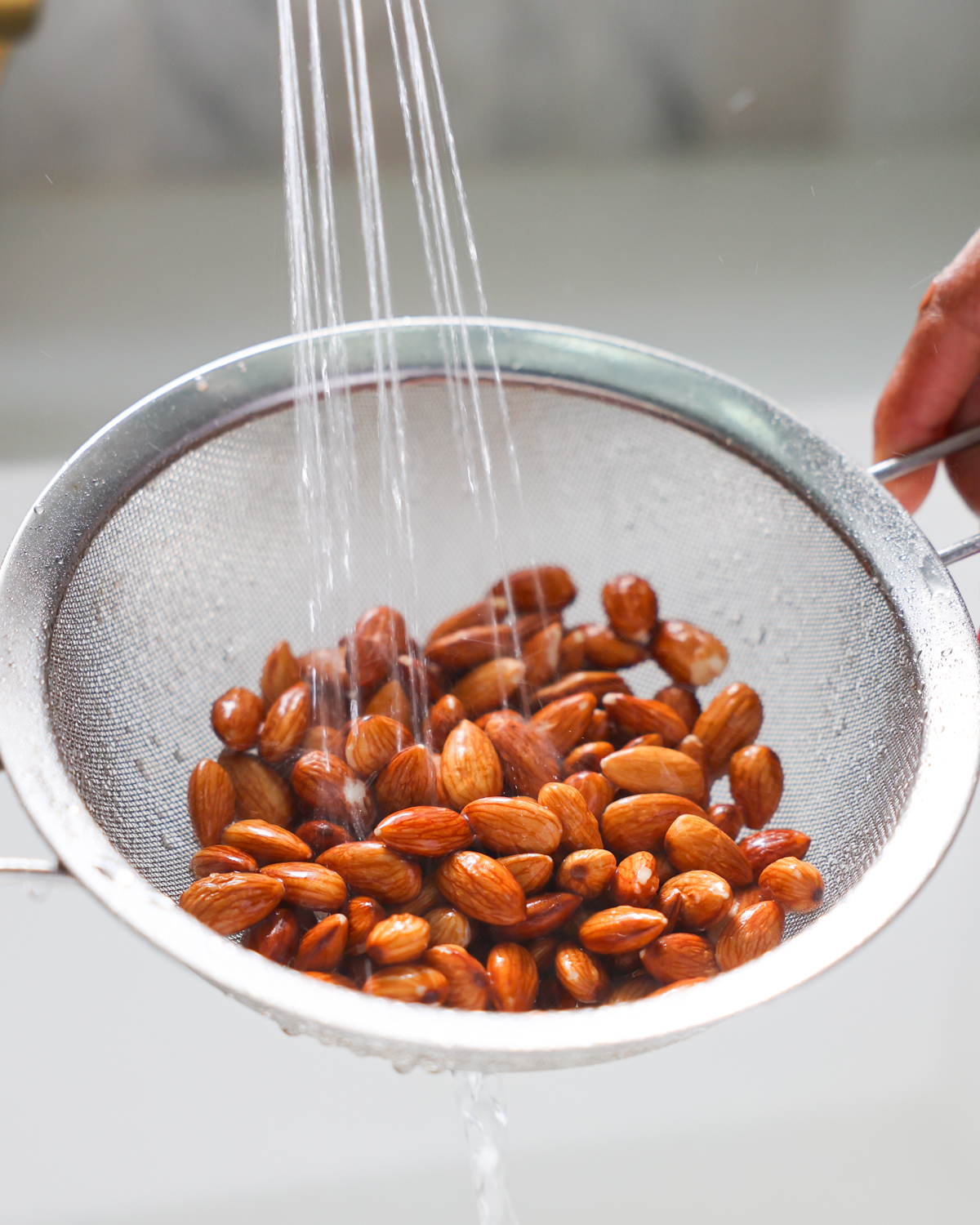

- Blend the almonds. Add the soaked almonds, 4 cups of fresh purified water, and a pinch of salt to a high-speed blender. Blend on high until the mixture is smooth and creamy, about 1-2 minutes depending on the strength of your blender.
Pro-Tip: See the Recipe Mix-Ins section below for how to add optional flavors.
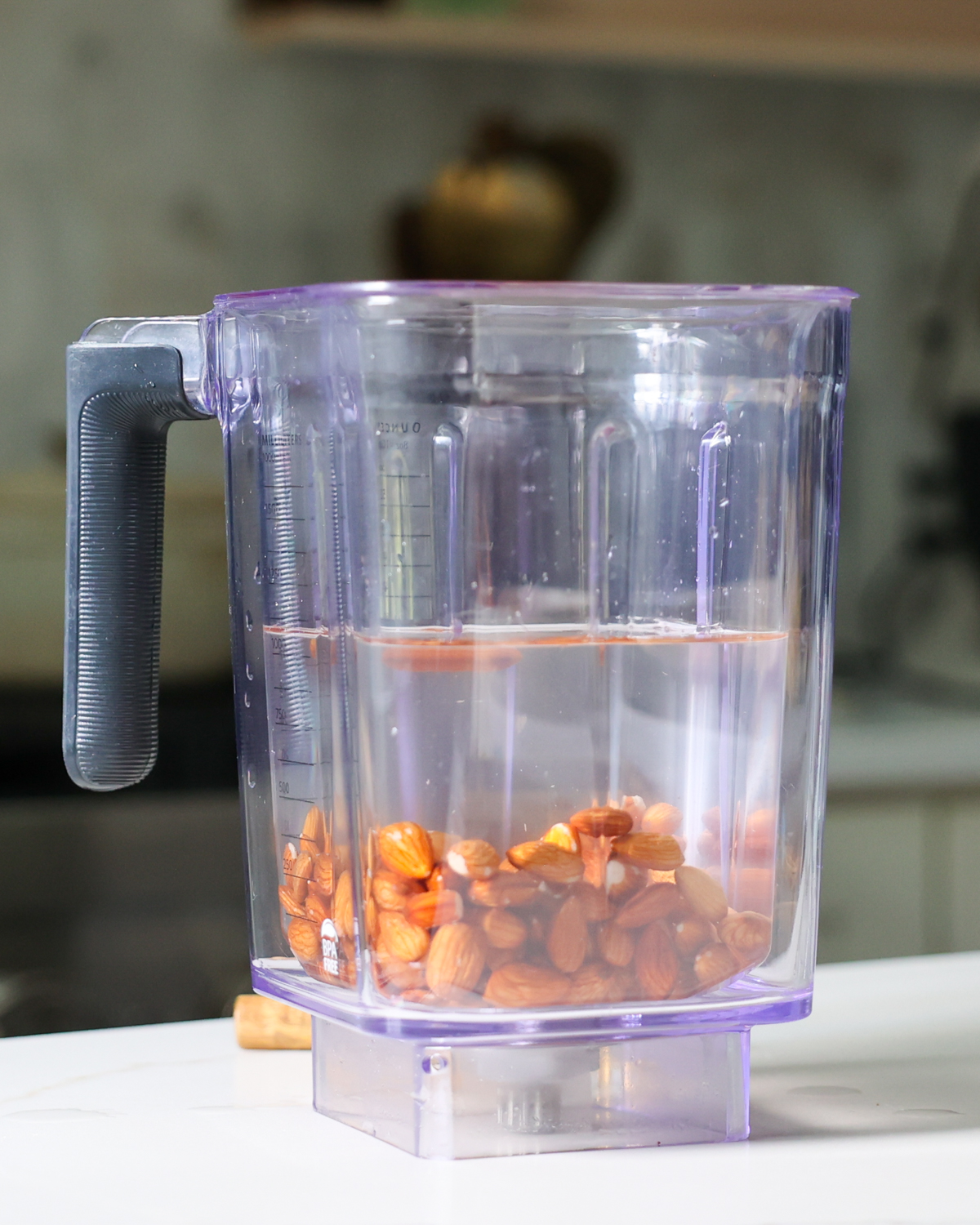

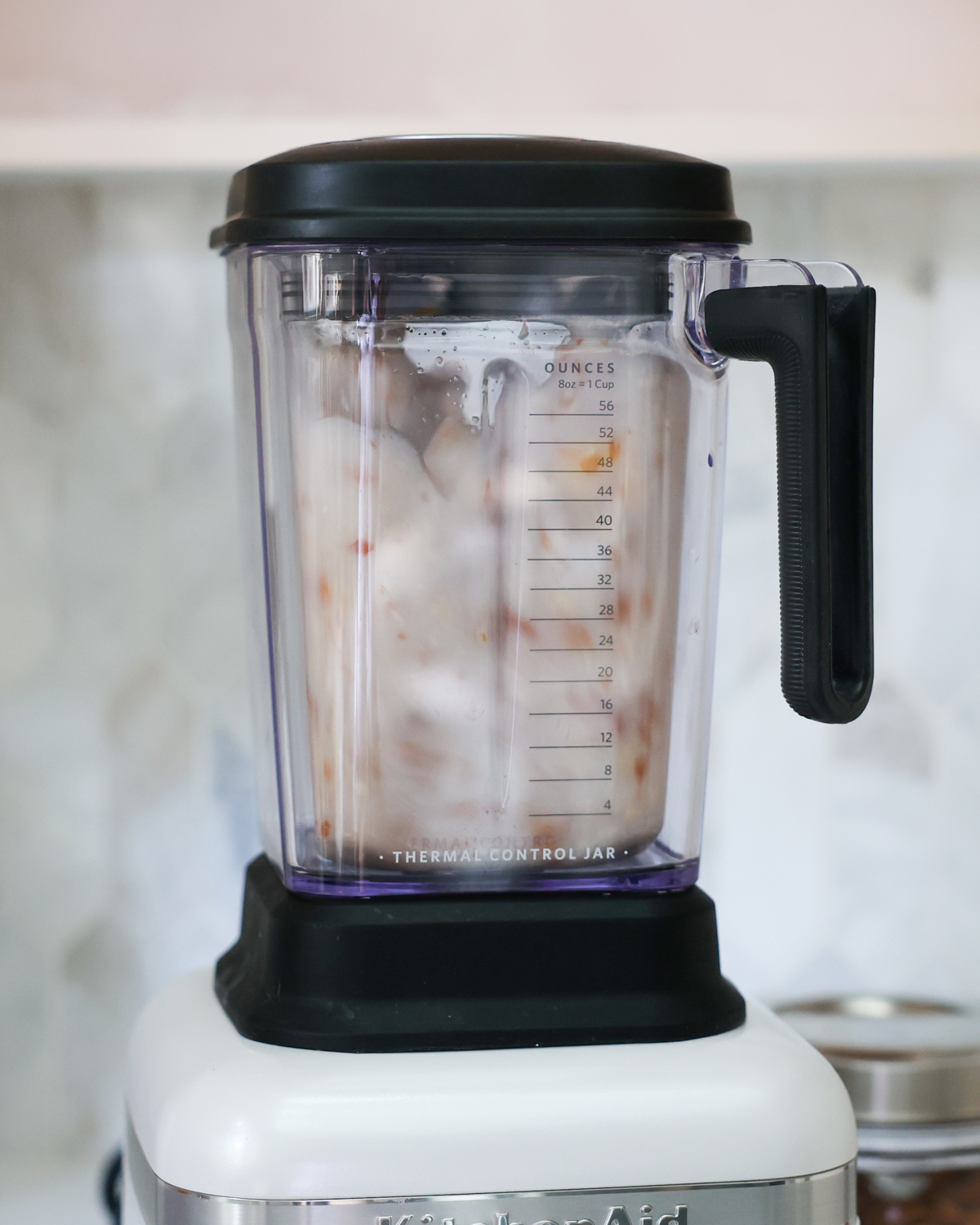

- Strain the milk. Place a cheesecloth or nut milk bag over a large bowl or jar. Slowly pour the almond mixture through the cloth, then use clean hands to squeeze out as much liquid as possible. This separates the almond milk from the almond pulp.
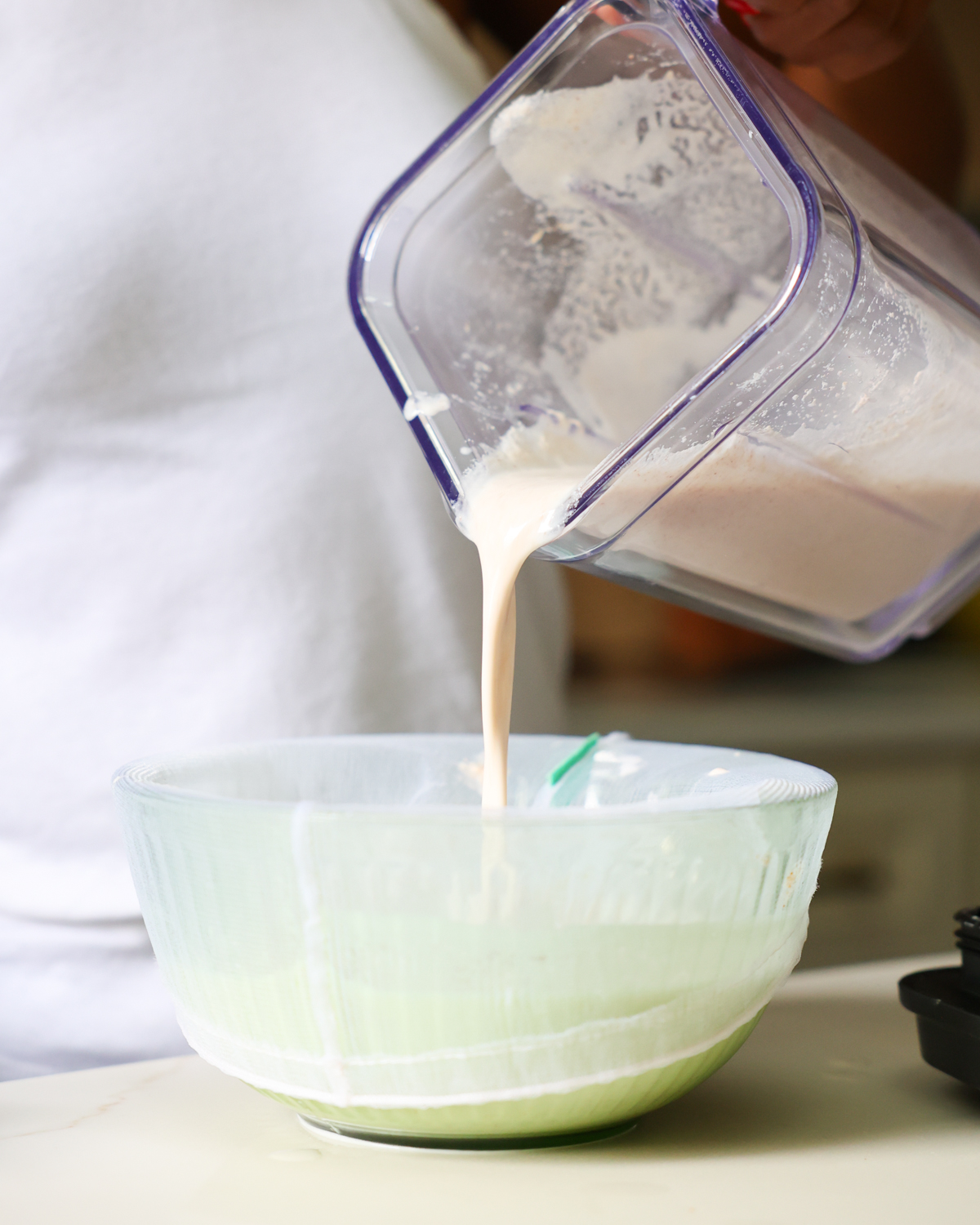

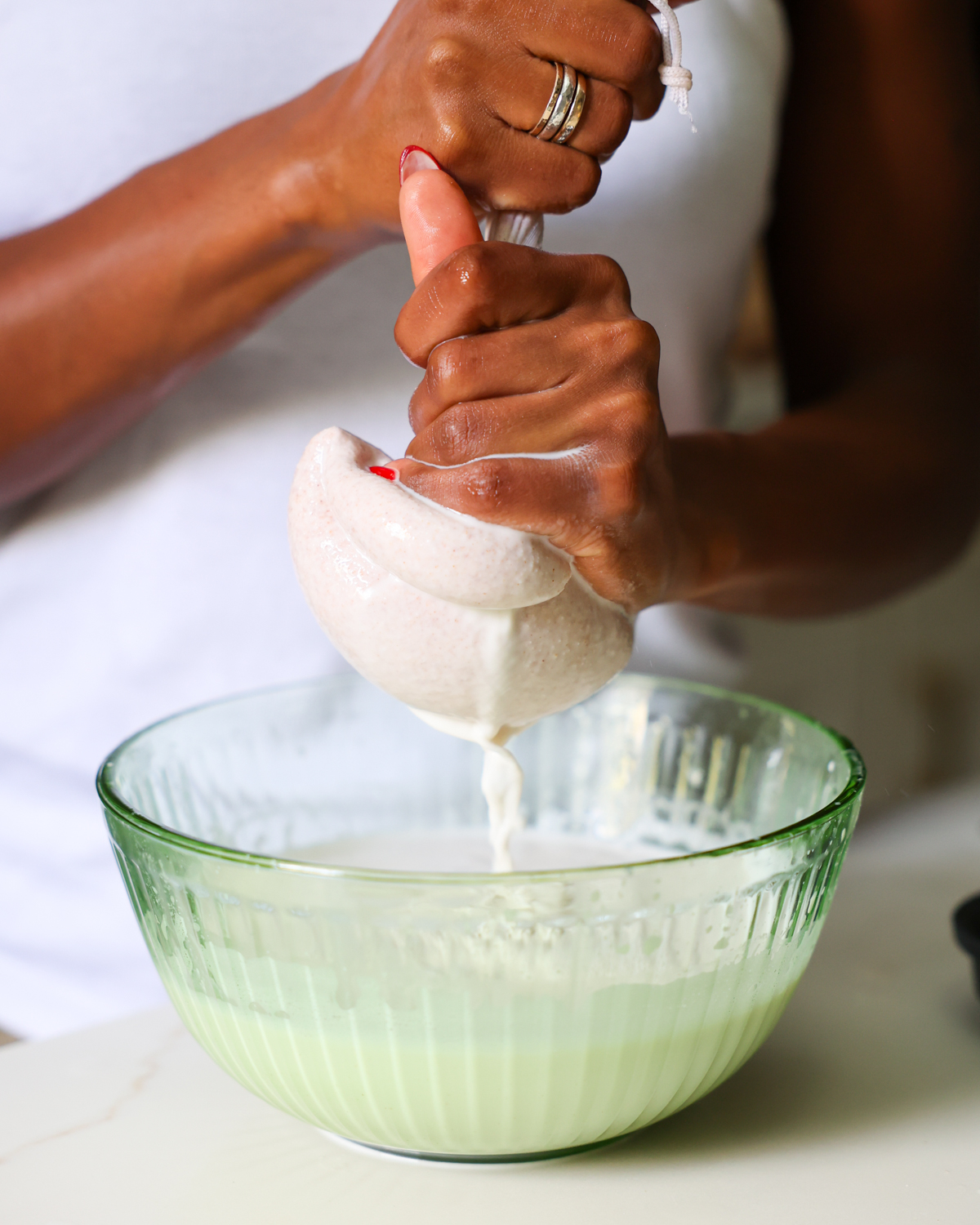

- Bottle and store. Transfer the fresh almond milk into a glass jar or bottle with a lid. Store in the refrigerator for up to 3-5 days. Shake well before using, as some separation is natural.
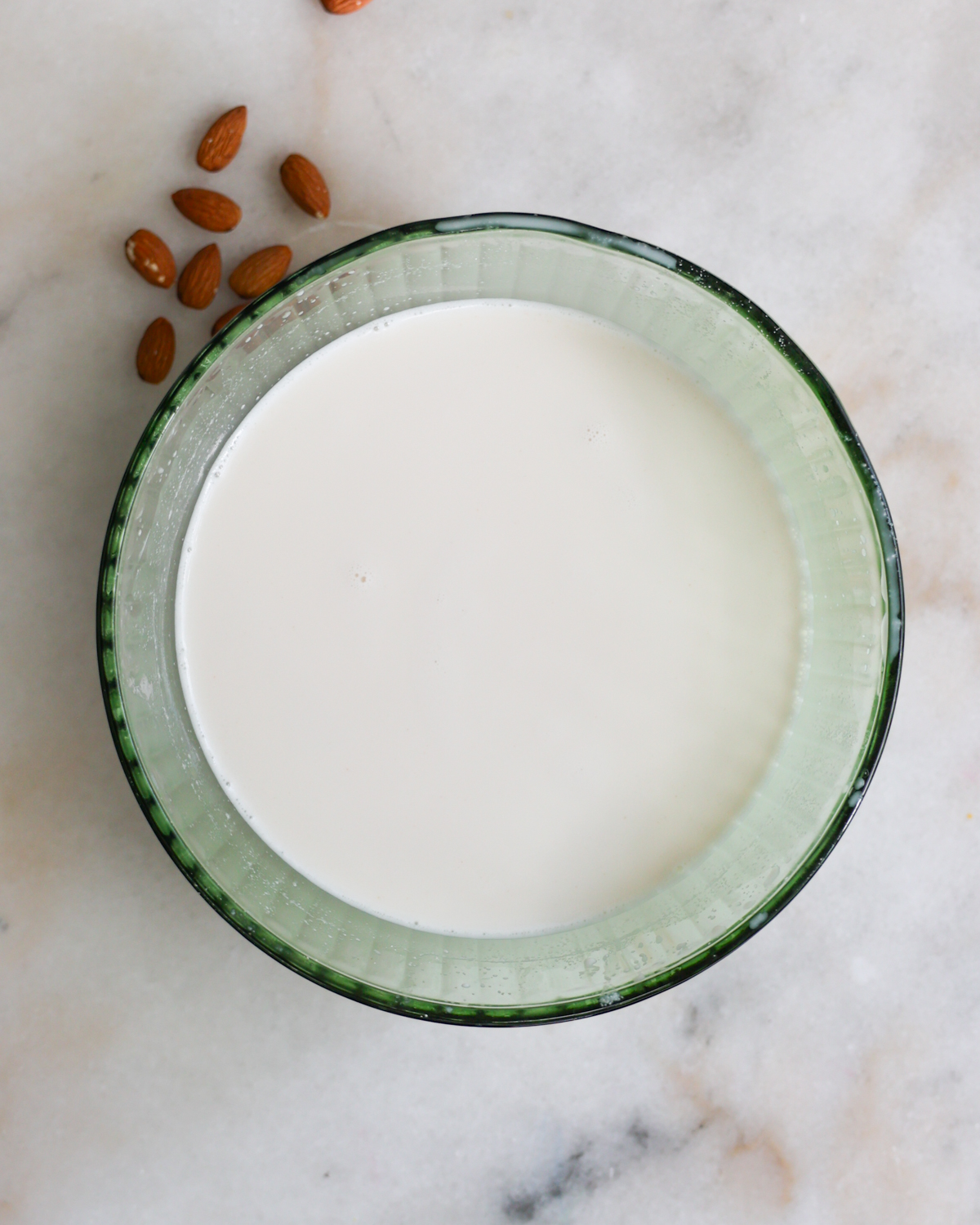

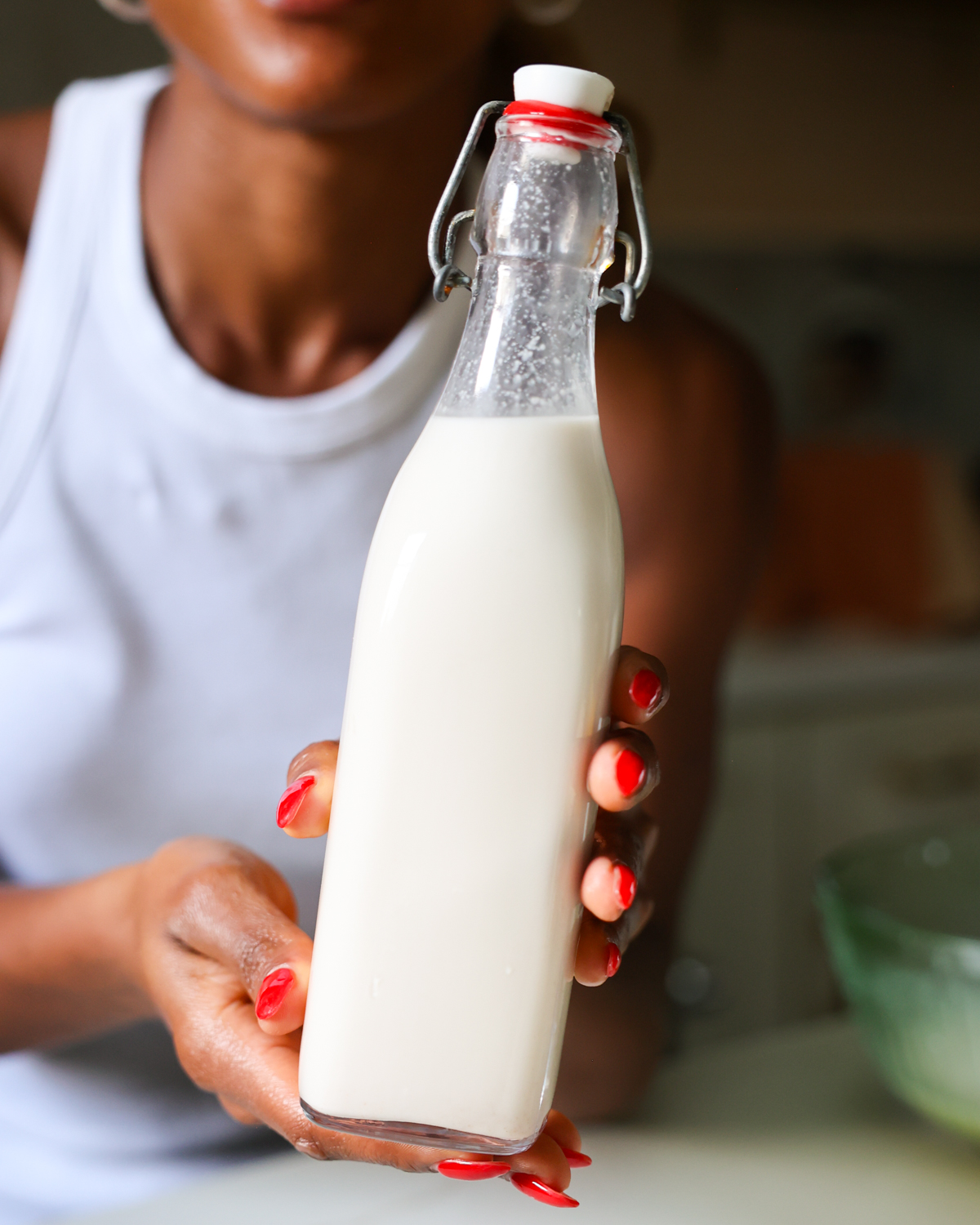

Jenné’s Recipe Tips
- Don’t skip the soak! Allow at least 8-12 hours for the almonds to soak for the best results. If you’re in a rush, quick-soak the nuts for half an hour. To do so: cover the almonds with water, bring to a boil, then remove from the heat and let them sit in the hot water for 30 minutes.
- Blend until smooth. Use a high-speed blender to fully break down the almonds for the richest texture and flavor.
- Customize thickness. For a thinner almond milk use 5 cups of water rather than 4 cups.
- Strain thoroughly. Squeeze as much excess liquid as possible using a cheesecloth or nut milk bag for maximum yield.
- Save the pulp. After straining the almond milk, don’t toss the almond pulp! Allow it to dry out and use it as a nutrient boost in baking or smoothies. You can also use it in place of whole almonds in energy balls. I like to dry it in the dehydrator or the oven (1 hour at 300°F) to save for later.
- Shake before enjoying. Give your container of almond milk a good shake before enjoying to mix up any settled natural solids and ensure a creamy, even texture with every pour.
Recipe Mix-Ins
Homemade almond milk is endlessly customizable. Include these almond milk ingredient variations for fun flavors, and mix and match for tasty combos:
- Vanilla Almond Milk: Once the almond milk is strained, return it to the blender and add 1 teaspoon pure vanilla extract, ½ teaspoon vanilla bean paste, or scrape the seeds from half a vanilla bean. If using vanilla bean paste, you’ll see beautiful little vanilla flecks in the finished almond milk.
- Chocolate Almond Milk: Once the almond milk is strained, return it to the blender and blend with 1-2 tablespoons unsweetened cacao powder or carob powder for a rich, chocolatey flavor. Sweeten if desired or add vanilla.
- Sweetened Almond Milk: For natural sweetness without refined sugar, add 2 pitted Medjool dates (soaked in hot water for 10-15 minutes) to the blender with the almonds and water, then strain per the recipe. Or add up to 1 tablespoon of maple syrup or 1 tablespoon of coconut nectar to the milk after straining it. Adjust sweetness based on preference.
- Spiced Almond Milk: Add ½ teaspoon ground cinnamon, nutmeg, or cardamom to the strained almond milk, and stir well for a cozy, warming flavor.
- Strawberry Almond Milk: Blend ½ cup fresh strawberries (hulled) or ¼ cup freeze-dried strawberries with the almonds and water. Strain according to the recipe instructions for a fruity, lightly pink milk.
- Blueberry Almond Milk: Once the almond milk is strained, return it to the blender and blend with 1-2 teaspoons of blueberry powder for a subtle berry flavor and a pretty lavender-blue hue.
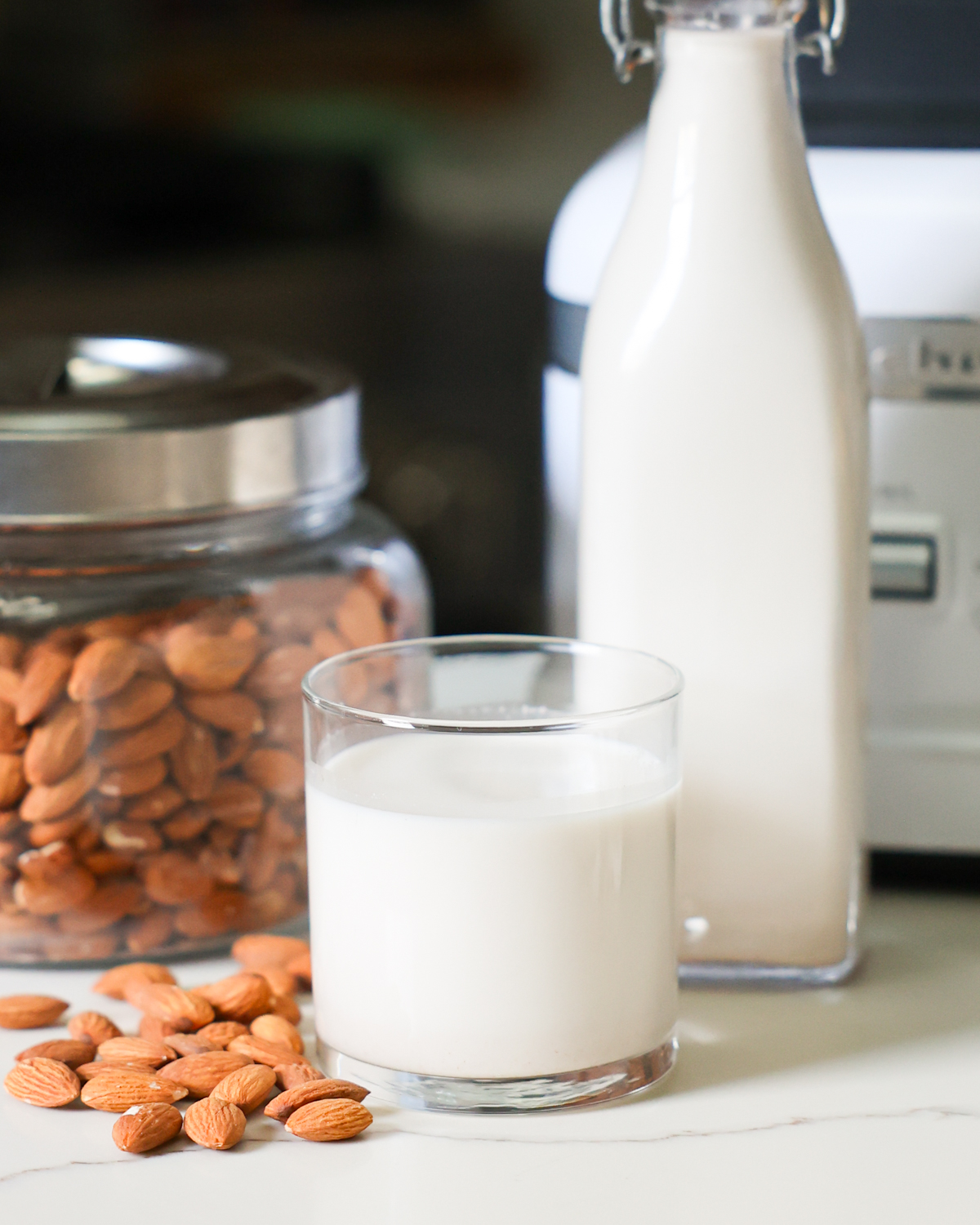

Serving Suggestions
This homemade almond milk recipe is incredibly versatile. Use it as the base for smoothies or cereal, in baking recipes, frothed into your favorite morning drink, or enjoy a cold glass with a tasty sweet treat. Here are a few of my favorite ways to use it:
Storage Directions
- Refrigeration: Store prepared almond milk in a sealed glass jar or bottle with a lid in the fridge for up to 4-5 days. Shake well before each use.
- Freezing: Almond milk can be frozen in ice cube trays for up to 3 months. Use frozen in smoothies or thaw in the fridge or at room temperature to use in baking or cooking recipes.
Frequently Asked Questions
Yes, I recommend straining for a smooth, silky texture.
Dry it out in the oven at a low temperature and use it in baking, oatmeal, smoothies, or as a base for energy bites. To dry the pulp, spread it evenly on a baking sheet and bake at 300°F for one hour, or until it feels completely dry.
Yes! This almond milk recipe can be gently warmed for hot drinks like lattes, chai, or hot chocolate. Avoid boiling, as it may separate slightly. Just warm over low heat and stir.
Separation is entirely natural, as this recipe uses no stabilizers or emulsifiers. Always shake your almond milk container well before using to recombine the liquid and achieve a smooth texture.
More Almond Recipes
- 1 cup raw almonds, soaked overnight with purified or
- 4 cups purified or spring water, plus more for soaking
- Optional flavor additions, dates, maple syrup, coconut nectar, cinnamon, vanilla bean, vanilla extract, carob powder, cacao/cocoa powder
- 1/8 tsp sea salt, or himalayan pink salt
Prevent your screen from going dark
-
Place the raw almonds in a large bowl or pitcher and cover with cool purified or spring water. Soak overnight (8-12 hours) until they are plump and soft. Drain and rinse before using.
-
Add the soaked, drained almonds to a high-speed blender with 4 cups of fresh purified or spring water and salt. Blend on high until the mixture is smooth and creamy, about 1-2 minutes.
-
If using them, add any optional flavor additions following the directions in the recipe notes section below.
-
Place a cheesecloth or nut milk bag over a large bowl or jar. Slowly pour the almond mixture through the cloth, then use clean hands to squeeze out as much liquid as possible.
-
Transfer the fresh almond milk into a glass jar or bottle with a lid. Store in the refrigerator for up to 3-5 days. Shake well before using, as some separation is natural.
- Vanilla Almond Milk: Once the almond milk is strained, return it to the blender and add 1 teaspoon pure vanilla extract, ½ teaspoon vanilla bean paste, or scrape the seeds from half a vanilla bean. If using vanilla bean paste, you’ll see beautiful little vanilla flecks in the finished almond milk.
- Chocolate Almond Milk: Once the almond milk is strained, return it to the blender and blend with 1-2 tablespoons unsweetened cacao powder or carob powder for a rich, chocolatey flavor. Sweeten if desired or add vanilla.
- Sweetened Almond Milk: For natural sweetness without refined sugar, add 2 pitted Medjool dates (soaked in hot water for 10-15 minutes) to the blender with the almonds and water, then strain per the recipe. Or add up to 1 tablespoon of maple syrup or 1 tablespoon of coconut nectar to the milk after straining it. Adjust sweetness based on preference.
- Spiced Almond Milk: Add ½ teaspoon ground cinnamon, nutmeg, or cardamom to the strained almond milk, and stir well for a cozy, warming flavor.
- Strawberry Almond Milk: Blend ½ cup fresh strawberries (hulled) or ¼ cup freeze-dried strawberries with the almonds and water. Strain according to the recipe instructions for a fruity, lightly pink milk.
- Blueberry Almond Milk: Once the almond milk is strained, return it to the blender and blend with 1-2 teaspoons of blueberry powder for a subtle berry flavor and a pretty lavender-blue hue.
Storage Directions
- Refrigeration: Store prepared almond milk in a sealed glass jar or bottle with a lid in the fridge for up to 4-5 days. Shake well before each use.
- Freezing: Almond milk can be frozen in ice cube trays for up to 3 months. Use frozen in smoothies or thaw in the fridge or at room temperature to use in baking or cooking recipes.
Calories: 35kcal | Carbohydrates: 1g | Protein: 1g | Fat: 3g | Polyunsaturated Fat: 2g | Monounsaturated Fat: 2g | Sodium: 325mg | Fiber: 1g | Sugar: 0.3g | Calcium: 300mg
